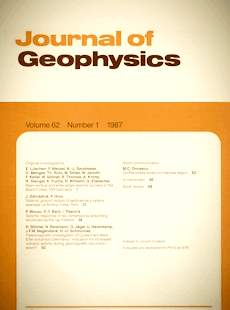A study of diffraction-like events on DEKORP2-S by Kirchhoff theory
Article Sidebar

Vols. 1-18 (1924-1944), ISSN 0044-2801
Main Article Content
Abstract
A method is described for calculating the seismic response of an arbitrarily shaped interface below a homogeneous medium by the Kirchhoff integral in the time domain. It is shown, by comparison with other numerical techniques, that this method yields accurate results for reflections. The errors in calculating diffractions are tolerable if the distance of the receiver from the shadow boundary of reflection is not too large; this is usually the case in horizontal seismic profiling. The method has been applied to model qualitatively some typical features in record sections of the deep seismic reflection profile DEKORP2-S. This profile is characterized by numerous strongly curved events that are concentrated mainly in two areas of the profile. These signals can be addressed as diffractions from an interpretation of the travel times. Dynamic calculations, however, show that the surprisingly high amplitudes cannot be explained by diffracting elements like fault edges or small-scale inhomogeneities; instead, one has to assume cylindrically or spherically curved reflectors with a radius of at least 4 km. Some possible geological explanations for these structures, like diapiric intrusions or antiformal stacks, are discussed in view of the tectonic evolution of the Central European Variscides.
 ARK: https://n2t.net/ark:/88439/y087788
ARK: https://n2t.net/ark:/88439/y087788
Permalink: https://geophysicsjournal.com/article/137
Article Details
References
Berryhill, J.R. (1977) Diffraction response for nonzero separation of source and receiver. Geophysics 42(6):1158-1176
Blundell, D.J., Raynaud, B. (1986) Modeling lower crust reflections observed on BI RPS profiles. In: Barazangi, M., Brown, L. (Eds.) Reflection seismology: a global perspective, pp. 287-295. AGU Geodynamics Series, Vol. 13, Washington D.C.
Carter, J.A., Frazer, L.N. (1983) A method for modeling reflection data from media with lateral velocity changes. J. Geophys. Res. 88:6469-6476
DEKORP Research Group (1985) First results and preliminary interpretation of deep-reflection seismic recordings along profile DEKORP2-South. J. Geophys. 57:137-163
Deregowski, S.M., Brown, S.M. (1983) A theory of acoustic diffractors applied to 2-D models. Geophys. Prosp. 31:293-333
Edel, J.B. (1982) Le socle varisque de l'Europe moyenne apports du magnetisme et de la gravimetrie. Sci. Geol. Bull. 35:207-224
Fertig, J., Muller, G. (1979) Approximate diffraction theory for transparent half-planes with application to seismic-wave diffraction at coal seams. J. Geophys. 46:349-367
Frazer, L.N., Sen, M.K. (1985) Kirchhoff-Helmholtz reflection seismograms in a laterally inhomogeneous multi-layered elastic medium - I. Theory. Geophys. J.R. Astron. Soc. 80:121-147
Hilterman, F.J. (1970) Three-dimensional seismic modeling. Geophysics 35(6):1020-1037
Hutton, G.D. (1987) The perfectly reflecting wedge used as a control model in seismic diffraction modelling. Geophys. Prosp. 35:681-699
Matthews, D.H., Cheadle, M.J. (1986) Deep reflections from the Caledonides and Variscides west of Britain and comparison with the Himalayas. In: Barazangi, M., Brown, L. (Eds.) Reflection seismology: a global perspective, pp. 5-19. AGU Geodynamics series, Vol. 13, Washington D.C.
Muller, G. (1977) Earth-flattening approximation for body waves derived from geometric ray theory - improvements, corrections and range of applicability. 1. Geo phys. 42:429-436
Schilt, F.W., Kaufman, S., Long, G.H. (1981) A three-dimensional study of seismic diffraction patterns from deep basement sources. Geophysics 46(12):1673-1683
Schneider, W.A. (1978) Integral formulation for migration in two and three dimensions. Geophysics 43:49-76
Sen, K.S., Frazer, L.N. (1985) Kirchhoff-Helmholtz reflection seismograms in a laterally inhomogeneous multi-layered elastic medium - II. Computations. Geoph. J.R. Astron. Soc. 82:415-437
Setto, I., Meissner, R. (1986) Support of gravity modelling for seismic interpretation. Terra Cognita 6:346
Sullivan, M.F., Cohen, J.K. (1987) Prestack Kirchhoff inversion of common-offset data. Geophysics 52(6):745-754
Temme, P. (1984) A comparison of common-midpoint, single-shot, and plane wave depth migration. Geophysics 49, 1896--1907
Trorey, AW. (1970) A simple theory for seismic diffractions. Geophysics 35(5), 762-784
Trorey, AW. (1977) Diffractions for arbitrary source-receiver locations. Geophysics 42(6), 1177-1182
Weber, K. (1984) Variscan events: early Palaeozoic continental rift metamorphism and late Palaeozoic crustal shortening. In: Hutton, D.H.W., Sanderson, D.J. (Eds.) Variscan tectonics of the North Atlantic region, pp. 3-22. Special publication of the Geological Society. Blackwell, Oxford











